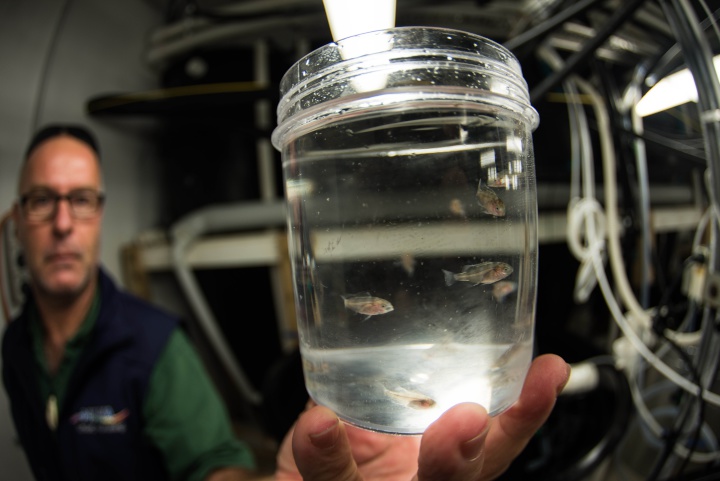Scientists send snapper to boot camp
Scientists send snapper to boot camp

At a laboratory just outside
Whangarei, scientists are putting very young snapper through
comprehensive physical testing - including a full medical
check-up involving smell, hearing, vision, and even anxiety
testing.
NIWA’s Northland Marine Research Centre at Bream Bay is the site for this experiment which aims to understand the effects of ocean acidification and warmer sea temperatures on snapper larvae.
“Most work in this area overseas is conducted on small, tropical reef fish. To be able to look at the effects of climate change on such a highly valued commercial, customary and recreational species as snapper in New Zealand is a first for us and very exciting,” says NIWA marine ecologist Dr Darren Parsons.
The experiment is a collaboration between NIWA, Prof Phillip Munday of James Cook University in Australia, and the University of Auckland under the auspices of the Ministry for Primary Industries biodiversity fund as well as CARIM (Coastal Acidification, Rate, Impacts and Management).
CARIM is a four-year project funded by the Ministry for Business, Innovation and Employment aimed at establishing the scale of acidification and how it is affecting iconic NZ species such as paua, mussels and snapper, and also New Zealand coastal ecosystems.
The snapper experiment began last month when adult broodstock were spawned at Bream Bay and the eggs placed in tanks under four different conditions. The eggs and larvae were used for the experiment because, compared to adult fish, they are the most vulnerable to environmental change.
In one set of tanks the temperature is 18°C, which matches normal conditions at the time of spawning. In other tanks the temperature is 22°C, closer to sea surface temperatures reached this summer due to a marine heatwave.
Carbon dioxide levels are being kept at present oceanic levels in the third set of tanks, and then raised in the fourth set of tanks to match those expected at the end of this century. Each tank was stocked with thousands of eggs.
During the first 35 days, after the eggs hatched into larvae but before they became juvenile fish, scientists monitored how fast they grew, photographed them, and counted how many died.
The scientists are also watching changes in the behaviour of the fish as they regulate the pH in their systems.
“To compensate for rising CO2 levels, fish regulate the levels of bicarbonate and chloride ions in their blood. These changes are thought to influence a neurotrasmitter in their brains, and in some other species this has resulted in a range of different behaviour and sensory effects being displayed,” Dr Parsons says.
For example, fish will normally swim away from water if they can smell a predator nearby. But when that water is treated with high CO2, some other species have been shown to swim towards it. “This could potentially end up causing high mortality in the wild.”
In a flume tank the larvae are tested for “swimmability” with increasing water flows.
“The flume tank is like a treadmill for fish. We ramp up the speed of the treadmill until the fish can’t swim forward anymore to give us an idea of their aerobic performance and how this differs for larvae from the different experimental conditions.”
Vision and hearing tests are also conducted
as well as the response of the fish to a startle stimulus
that measures their ability to escape from potential
harm.
Dr Parsons says this research is a “first cut”
at looking at the direct effects of ocean acidification and
increased temperature on fish in New Zealand
waters.
“While it will take a lot of evidence before these kinds of issues can be built into management advice, this is a start at figuring out the scale of the issues and how they might unfold over time.”
Dr Parsons said the combination of Australian expertise in this field combined with NIWA’s experience with broodstock and husbandry at Bream Bay provided a unique situation for the experiments to go ahead.
“It is very exciting to be at a point where we
can bring this expertise together.”


 Antarctic Heritage Trust: NZ-made ‘Cutting-Edge’ VR Experience Tours The UK
Antarctic Heritage Trust: NZ-made ‘Cutting-Edge’ VR Experience Tours The UK Brian Gaynor Business Journalism Initiative: Brian Gaynor Initiative Business Journalism Funding Award Moves To Rolling Applications
Brian Gaynor Business Journalism Initiative: Brian Gaynor Initiative Business Journalism Funding Award Moves To Rolling Applications  Inland Revenue: Fifth Anniversary Of The SBC Loans - Time To Repay
Inland Revenue: Fifth Anniversary Of The SBC Loans - Time To Repay Te Runanga o Ngati Hinemanu: First Marae Based Fresh Water Testing Science Lab Grand Opening 16-17 May 2025
Te Runanga o Ngati Hinemanu: First Marae Based Fresh Water Testing Science Lab Grand Opening 16-17 May 2025 Raise Communications: NZ Careers Expo Kicks Off National Tour Amid Record Unemployment
Raise Communications: NZ Careers Expo Kicks Off National Tour Amid Record Unemployment Hugh Grant: How To Build Confidence In The Data You Collect
Hugh Grant: How To Build Confidence In The Data You Collect